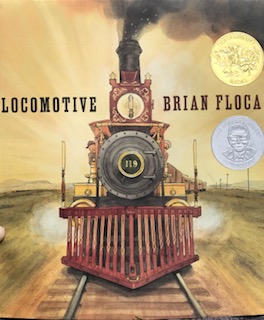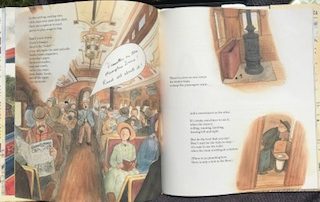 Title: Locomotive
Title: Locomotive
Author: Brian Floca
Illustrator/Photographer: Brian Floca
Publisher: An imprint of Simon and Schuster Children’s Publishing
Year: 2013
Number of Pages: 64
Tags: Adventure, Award Book, Non-fiction, Picture Book, K-5, Taylor Krueger
Genre: Picture Book Non-Fiction
Analysis: This book teaches readers about the first transcontinental railroad that was built in the year of 1869. This nonfiction story takes the reader through the steps of building the railroad, passengers traveling cross country on the train, and all the in between measures taken to make this railroad run smoothly. The stories of crew members that make the railroad run, stories of families heading West in search of a better life, and informational facts of history are depicted throughout the book.
The illustrations of this book do not have borders and are integrated with the text. Since the images do not have borders this represents the reader viewing the actions of characters from within, almost as if the reader was present in the illustrations. There are also many different illustrations scattered throughout the pages that enhance the text. The presence of small illustrations framed by rounded vanishing lines show that the railroad and characters are more secure. These images are very detailed and give the reader a glimpse into the world of the nineteenth-century, almost as though the reader was looking into a  window of the past. The colors used throughout the book are very soothing and give a feeling of calmness to the reader. The use of light browns and yellows, blue, and soft mellow colors connect to the time period of the building of the transcontinental railroad.
window of the past. The colors used throughout the book are very soothing and give a feeling of calmness to the reader. The use of light browns and yellows, blue, and soft mellow colors connect to the time period of the building of the transcontinental railroad.
The perceptual view of the characters and settings tell a story of the trip to the West. There are depictions of building the train, riding the train, and the scenery that is seen throughout the trip. The structure of the illustrations have the facial expressions of the characters to vary from seriousness, happiness, and contentedness. There are numerous characters throughout the book, but there seems to be a mother and son that is a focus of the book. These characters are often drawn as small compared to other crew members on the train, therefore it represents their position as passengers. This book shows the historical ideology of the evolution of travel during the nineteenth century. It shows the transformation of the new social aspect that connects both ends of the country.
This book is a representation of a multimodal text, as the words and illustrations interact creating expectations of each other. The illustrations further amplify the meaning of the text. Since the author is also the illustrator, the illustrations are a direct replica of what the author imagined the text to show. The illustrations develop the setting and places traveled throughout the novel, as the reader may not be familiar with the landmarks in the text. The images create coherence with the text. The text is very well created, as there are large bold words in different fonts and colors shown throughout the pages. These words are commonly sounds made by the train, and give character to the book not commonly seen in other historical picture books.
In each inside cover of the book there are historical information of the transcontinental railroad. Also, on the inside cover of the back of the book there is a breakdown of each part of the trains used on the railroad. These detailed historical descriptions give greater insight to the reader on the background knowledge of this monumental transformation of transportation.
